"Cherishing Little Steps - A Haven for Baby and Family Journeys"
Choosing the Right Childcare
Are you a parent who is struggling to find the right childcare for your little one? Don’t worry, you’re not alone! Choosing the right childcare can be a daunting task, but it’s important to make the right decision for your child’s well-being and development.
With so many options available, it’s essential to assess your child’s needs and find a childcare facility that meets them. From understanding different childcare options to considering location and convenience, there are several factors to consider.
You’ll want to evaluate the facility’s safety measures, examine staff qualifications and experience, and ensure a nurturing and stimulating environment. By taking these steps, you can make an informed decision and find the perfect childcare for your child.
Key Takeaways
- Consider your child’s unique developmental needs
- Understand different childcare options
- Choose a convenient location
- Evaluate the facility’s safety measures
- Examine staff qualifications and experience
Assessing Your Child’s Needs
Assess your child’s specific requirements when selecting childcare. It’s essential to consider your child’s unique developmental needs and identify any special needs they may have. Assessing your child’s development is crucial in ensuring they receive the appropriate care and support in their early years.
Start by observing your child’s behavior and interactions with others. Look for signs of social and emotional development, such as how they interact with peers and adults, their ability to express their feelings, and their level of independence. Consider their cognitive development, including their language skills, problem-solving abilities, and curiosity about the world around them.
Identifying any special needs your child may have is equally important. This could include physical disabilities, learning difficulties, or behavioral challenges. Take note of any specific accommodations or support your child may require to thrive in a childcare setting.
Understanding Different Childcare Options
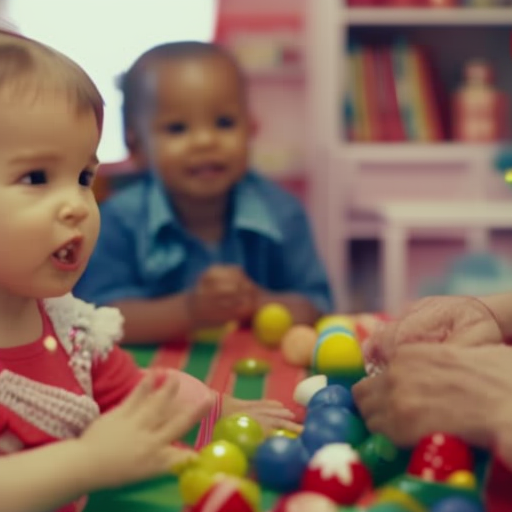
Consider the various types of childcare available to meet your child’s needs and provide them with a nurturing environment for growth and development. When it comes to childcare options, you have two primary choices: home-based childcare or center-based childcare.
Home-based childcare involves leaving your child in the care of a provider who operates out of their own home. This option offers a more intimate setting and a potential for a closer relationship between your child and the caregiver.
On the other hand, center-based childcare involves enrolling your child in a daycare facility, where they’ll interact with a larger group of children and multiple caregivers. This option provides your child with the opportunity for social interaction and exposure to a variety of activities and learning experiences.
Both options have their benefits, but it’s important to consider your child’s individual needs and preferences. Some children thrive in a smaller, homelike environment, while others thrive in a more structured and social setting.
It’s also worth noting that social interaction plays a crucial role in a child’s development. Interacting with peers helps them develop important social skills, such as sharing, taking turns, and resolving conflicts. Additionally, being part of a larger group can stimulate their cognitive and emotional growth.
Considering Location and Convenience
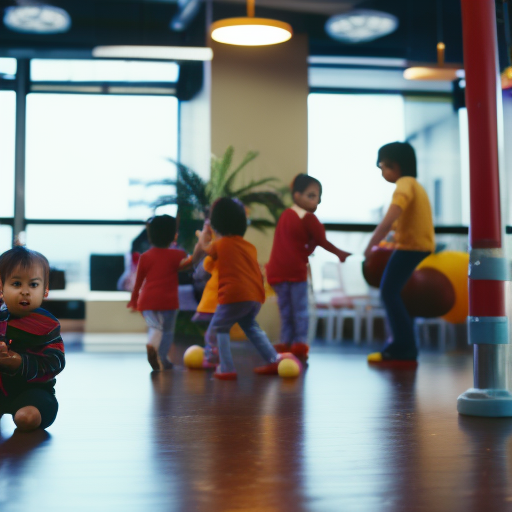
When choosing the right childcare, it’s important to think about the location and convenience for you and your child. Considering the location advantages and convenient services of a childcare center can significantly impact your daily routine and overall satisfaction.
The location of your childcare center should ideally be close to your home or workplace. This not only saves you time and energy during drop-off and pick-up but also ensures that your child is in a familiar and comfortable environment. Having a childcare center nearby allows you to quickly respond to any emergencies or attend events or activities organized by the center.
Convenient services offered by the childcare center can make your life easier and more manageable. Look for centers that offer extended hours, flexible scheduling options, and additional services such as transportation or meals. These services can alleviate stress and provide you with the flexibility you need to balance work and personal responsibilities.
Furthermore, a childcare center that’s conveniently located and offers a range of services can foster a sense of community among parents. This can lead to valuable connections and support networks, as you navigate the challenges of parenting.
Evaluating the Facility’s Safety Measures
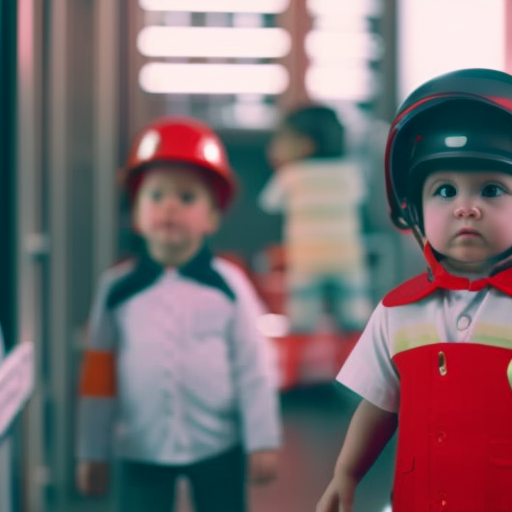
Ensure that the childcare facility has implemented adequate safety measures to protect your child. When evaluating the facility’s security measures, it’s essential to assess their emergency response plans as well. Safety should be a top priority when selecting a childcare facility, as it ensures that your child will be protected and well cared for.
Start by evaluating the facility’s security measures. Look for features such as secure entry systems, surveillance cameras, and properly maintained fences. These measures help prevent unauthorized access and ensure that your child is in a safe environment. Additionally, inquire about the facility’s emergency response plans. Find out if they’ve well-documented procedures in place for different types of emergencies, including fire drills, lockdown procedures, and evacuation plans.
It is also important to consider the staff’s training in safety and emergency response. Ask about their certifications, such as CPR and first aid training. In emergency situations, having staff members who are trained to handle medical emergencies and administer first aid can make a significant difference in your child’s well-being.
Lastly, trust your instincts. Visit the facility and observe the environment. Does it feel safe and secure? Are there any potential hazards that could pose a risk to your child? Don’t hesitate to ask questions and voice any concerns you may have.
Examining the Staff Qualifications and Experience

To ensure your child’s well-being and development, it’s crucial to examine the qualifications and experience of the childcare staff. The staff qualifications play a significant role in determining the quality of care your child will receive. Look for staff members who possess relevant certifications and educational backgrounds in early childhood education or a related field. These qualifications demonstrate their commitment to acquiring the necessary knowledge and skills to provide your child with a nurturing and enriching environment.
In addition to qualifications, staff experience is equally important. An experienced childcare provider can bring valuable insights and expertise to their role. Consider the number of years the staff members have been working in the field and whether they’ve experience with children in the same age group as your child. This experience allows them to understand the unique needs and developmental milestones of children at different stages.
When evaluating staff qualifications and experience, it’s also beneficial to inquire about their ongoing professional development. A childcare center that encourages and supports staff training and continuing education demonstrates a commitment to staying updated on best practices in early childhood education.
Exploring the Curriculum and Educational Approach
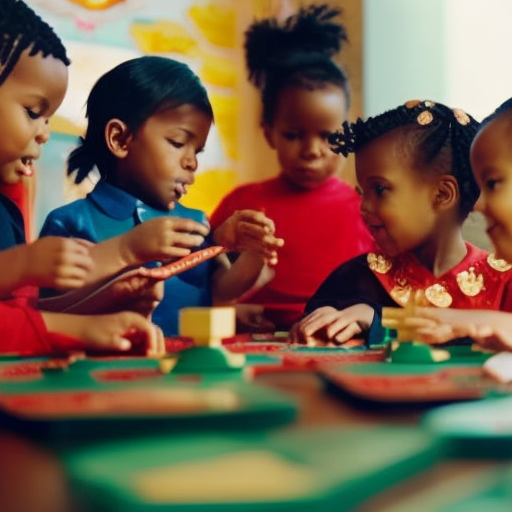
Take a closer look at the curriculum and educational approach to find the right childcare for your child. When considering different childcare options, it’s important to understand the educational philosophies and approaches they follow. Here are four key points to consider:
-
Educational Philosophies: Each childcare center may have a different educational philosophy that guides their approach to teaching and learning. Some centers may follow a Montessori approach, focusing on hands-on learning and individualized instruction. Others may embrace a Reggio Emilia philosophy, encouraging exploration and creativity. Understanding these philosophies will help you align your child’s needs and learning style with the center’s approach.
-
Play-Based Learning: Play is an essential part of a child’s development, and many childcare centers prioritize play-based learning. This approach recognizes that children learn best through play and encourages them to explore, experiment, and problem-solve through hands-on activities. Look for centers that provide ample opportunities for structured and unstructured play, as it promotes social, emotional, and cognitive growth.
-
Integrated Curriculum: A well-rounded curriculum should include various subjects and activities to support your child’s holistic development. Look for centers that offer a balanced mix of academic subjects, such as math and literacy, as well as art, music, and physical education. An integrated curriculum ensures that your child receives a comprehensive education and fosters their curiosity and love for learning.
-
Individualized Instruction: Every child is unique, and a childcare center that values individualized instruction is beneficial for their growth. Seek centers that understand and cater to each child’s specific needs, abilities, and interests. This personalized approach allows educators to tailor their teaching methods and activities to support your child’s development and maximize their potential.
Reviewing the Facility’s Cleanliness and Hygiene Practices

Consider the facility’s cleanliness and hygiene practices when choosing the right childcare for your child. Ensuring that the childcare facility maintains high cleaning practices and health standards is crucial for the well-being and safety of your child. When reviewing a potential childcare facility, it is important to inquire about their cleaning routines and protocols. A well-maintained and hygienic environment can prevent the spread of germs and reduce the risk of illness.
To help you assess the cleanliness and hygiene practices of a childcare facility, here is a table outlining some key areas to consider:
| Cleaning Practices | Health Standards |
|---|---|
| Regular disinfection of toys, surfaces, and equipment | Proper handwashing procedures for staff and children |
| Frequent changing and disposal of diapers | Adequate ventilation for fresh air circulation |
| Regular laundering of bedding and towels | Proper storage and handling of food |
Checking for a Nurturing and Stimulating Environment
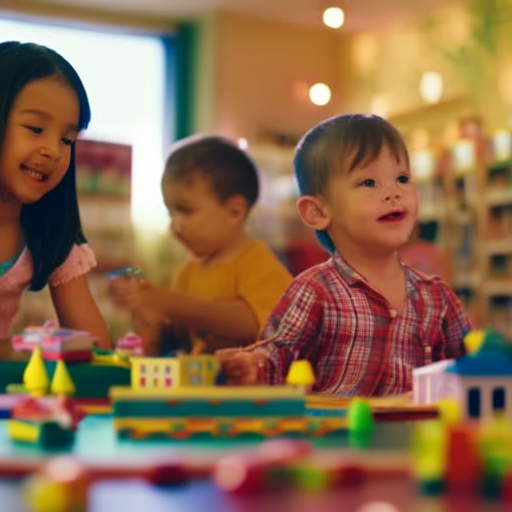
When choosing the right childcare for your child, it’s essential to ensure that the facility provides a nurturing and stimulating environment on a daily basis. A nurturing environment is crucial for your child’s overall development and emotional well-being. It should be a place where your child feels safe, loved, and supported.
A stimulating environment, on the other hand, encourages learning and exploration through various activities and experiences. Here are some key factors to consider when checking for a nurturing and stimulating environment:
-
Qualified and caring staff: The caregivers should be trained in child development and have a genuine passion for working with children. They should be warm, patient, and attentive to each child’s needs.
-
Age-appropriate activities: The facility should offer a wide range of activities that are suitable for your child’s age and developmental stage. These activities can include arts and crafts, music and movement, outdoor play, and sensory experiences.
-
Play-based learning: Look for a childcare center that emphasizes play-based learning. Play is a natural way for children to learn and develop essential skills like problem-solving, creativity, and social interaction.
-
Safe and stimulating environment: The facility should have age-appropriate toys, materials, and equipment. It should also be clean, well-maintained, and have adequate space for children to move and explore.
Understanding the Facility’s Policies and Procedures

To understand the facility’s policies and procedures, you should familiarize yourself with the rules and regulations governing the childcare center. This will ensure that you’re fully aware of how the center operates and what’s expected of both the staff and the parents.
One important aspect to consider is the facility’s communication policy. It’s crucial for parents to know how and when they’ll receive updates about their child’s progress, any incidents that may occur, and any changes in the center’s schedule or policies. Whether it’s through regular newsletters, emails, or phone calls, effective communication between the center and the parents is essential for maintaining a strong partnership.
Another critical area to look into is the facility’s emergency response procedures. You need to know how the center handles emergencies and what steps they take to ensure the safety and well-being of the children. Find out if the center has established protocols for different types of emergencies, such as fires, natural disasters, or medical emergencies. It’s important to understand how the staff is trained to handle these situations and how they communicate with parents during emergencies.
Considering the Costs and Financial Aspects

To accurately assess the financial impact of choosing a childcare facility, it’s crucial that you evaluate the overall costs associated with your child’s care. Here are some important factors to consider when it comes to the costs and financial aspects of childcare:
-
Tuition fees: Research and compare the fees charged by different childcare facilities in your area. Keep in mind that higher fees don’t always equate to better quality care.
-
Additional fees: Inquire about any additional fees that may be required, such as registration fees, activity fees, or meal fees. These can significantly impact your overall expenses.
-
Cost saving tips: Look for ways to reduce your childcare costs. For example, consider part-time care instead of full-time if it suits your schedule. Explore the possibility of sharing a nanny or hiring a nanny who provides care for multiple families.
-
Financial assistance options: Investigate if there are any financial assistance programs available in your area that can help alleviate the financial burden of childcare. Some government programs or nonprofit organizations may offer subsidies or vouchers to eligible families.
Seeking Recommendations and Conducting Visits

Start by asking trusted friends, family members, or neighbors for their recommendations on childcare facilities in your area. Personal referrals can provide valuable insights and help you narrow down your options. Once you have a list of recommendations, it’s time to conduct visits to the childcare centers.
Visiting the facilities in person allows you to get a firsthand look at the environment and observe how the staff interacts with the children. It’s important to pay attention to the cleanliness and safety measures in place. Look for well-maintained play areas, age-appropriate toys, and secure entrances.
During your visits, take the opportunity to ask questions and gather information. Inquire about the curriculum and educational activities offered, as well as the qualifications and experience of the caregivers. Find out about their policies on discipline, meals, and napping.
Observe how the caregivers engage with the children. Do they seem warm, attentive, and responsive? Are the children happy and engaged? Trust your instincts and assess whether the center aligns with your values and parenting style.
Frequently Asked Questions
What Are the Legal Requirements for Opening a Childcare Facility?
To open a childcare facility, you must meet the legal requirements. These include obtaining a childcare license and adhering to safety regulations. It’s important to ensure a safe and nurturing environment for the children in your care.
How Can I Ensure That My Child Will Receive Proper Nutrition and Meals While at Childcare?
When choosing childcare, you want to ensure your child gets proper nutrition. Ask about meal planning and any nutrition concerns. It’s important to have peace of mind knowing they’ll be well-fed and nourished.
Are There Any Specific Policies Regarding Discipline and Behavior Management at the Facility?
At the facility, their discipline policies and behavior management are key. They ensure a safe and structured environment for your child. You can trust that they have effective strategies in place to promote positive behavior and address any issues that may arise.
What Measures Are in Place to Prevent the Spread of Illnesses and Promote Good Hygiene Practices?
To prevent the spread of illnesses and promote good hygiene practices, childcare facilities implement measures like regular handwashing, proper sanitization of toys and surfaces, and teaching children about the importance of hygiene.
Can You Provide Information on the Facility’s Emergency Preparedness and Response Procedures?
We prioritize your child’s safety. Our facility conducts regular emergency drills and our staff receives comprehensive training on emergency preparedness and response procedures. You can trust us to keep your child secure.
Conclusion
Congratulations! You have successfully navigated the daunting task of choosing the right childcare for your little one.
With thorough assessments, understanding of options, consideration of location and safety, evaluation of staff qualifications, examination of nurturing environments, understanding of policies, and careful consideration of costs, you have made an informed decision.
Your child’s well-being and development are in good hands.
Now sit back and relax, knowing you have found the perfect place for your little one to grow and thrive.



Very interesting info!Perfect just what I was looking for!Money from blog